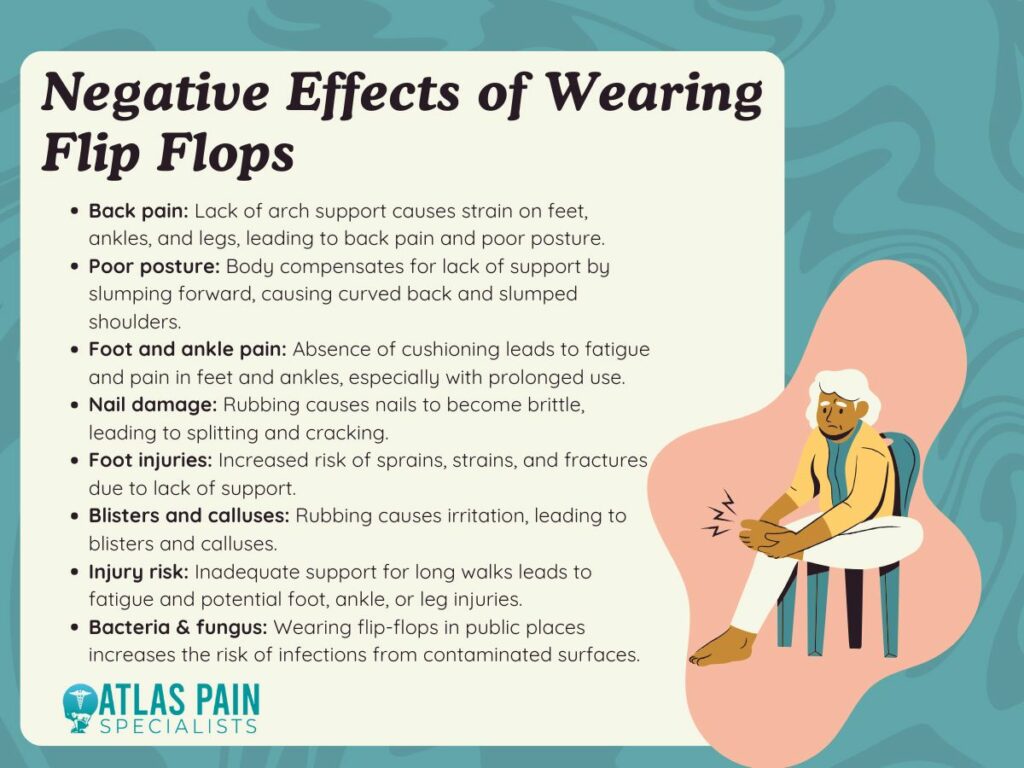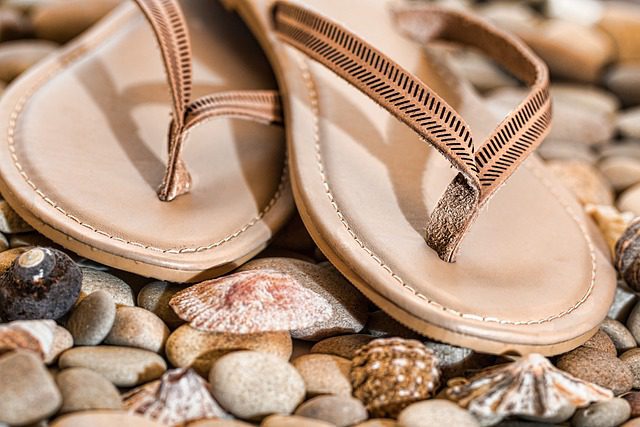

Are Flip Flops Bad For Your Back?
Flip-flops are a popular footwear choice for many people, particularly during the warm summer. They are easy to slip on and off, lightweight, and often inexpensive.
Are flip flops bad for your back? Despite their convenience, flip-flops can also negatively affect the back. This is because flip-flops lack the support and cushioning that other types of shoes provide, which can strain the feet, ankles, and back.
In this article, we will explore the potential adverse effects of flip-flops on the back, who is most at risk for back pain from flip-flops, and what can be done to reduce discomfort and injury.
The anatomy of the Foot and Back
Before delving into the effects of flip-flops on the back, it is essential to understand the anatomy of the foot and back. The foot is made up of 26 bones, 33 joints, and more than 100 muscles, tendons, and ligaments.
It is designed to absorb shock and provide stability while walking and standing. The arch of the foot is a critical component in this process, as it helps distribute weight and maintain balance.
On the other hand, the back is made up of the spinal column, which comprises 33 vertebrae, as well as muscles, tendons, and ligaments.
The spinal column is responsible for providing support and protection for the spinal cord and allowing for movement and flexibility. Check out the article on the ultimate guide to spinal cord stimulation.
Who is most at risk for back pain from flip-flops?
People with existing foot, ankle, or back issues
Those with conditions such as plantar fasciitis, heel spurs, hammertoes, or bunions may be more susceptible to pain from flip-flops.
Additionally, individuals with existing back issues may be more prone to discomfort and injury from the lack of support and cushioning provided by flip-flops.
People who spend long periods on their feet
Flip flops may not be suitable for those who spend long hours on their feet, such as waiters, nurses, or construction workers. The lack of support and cushioning can contribute to fatigue and discomfort, as well as increase the risk of injury.
People who engage in activities that put stress on the back
Flip flops may not be suitable for individuals who engage in activities that put extra stress on the back, such as running, hiking, or playing sports. The lack of support and cushioning can increase the risk of injury and make it more difficult to perform at one's best.
The Negative Effects of Wearing Flip Flops
Back Pain
There are many surprising causes of back pain. Flip flops don't provide arch support, which can cause your feet, ankles, and legs to overcompensate for the lack of support. This can lead to back pain and poor posture.
If you are experiencing back pain, wearing shoes that provide arch support and cushioning for your feet, ankles, and legs is best. Shoes with good arch support can help reduce strain on the lower back and improve posture. Additionally, it is vital to maintain a healthy weight, practice good posture, and engage in regular exercise to help reduce back pain.
Poor Posture
Wearing flip-flops can lead to poor posture as they provide little arch support. Without this support, the body will likely compensate by leaning forward and down, leading to a curved back and slumped shoulders.
Foot and Ankle Pain

Flip flops don't provide any cushion or arch support, so the feet and ankles must absorb the full shock of each step. This can lead to fatigue, aches, and pains in the feet and ankles, particularly if the flip-flops are worn for extended periods of time.
Nail Damage
Without any cushioning or arch support, flip-flops can cause nails to become brittle or split. The constant rubbing of the flip-flop against the nails can cause them to become brittle, leading to splitting and cracking.
Foot Injuries
Due to their lack of support, flip flops can cause foot injuries such as sprains, strains, and fractures. The lack of arch support makes it difficult for the foot to absorb shock, increasing the risk of injuries.
Blisters and Calluses
The lack of arch support and cushioning can cause blisters and calluses on the feet. The constant rubbing of the flip-flop against the skin can irritate it, leading to blisters and calluses.
Injury
Flip flops are not designed to provide adequate foot support, making them inadequate for walking long distances.
This can lead to fatigue and potentially severe injuries to the foot, ankle, and lower leg. Additionally, the thin straps of the flip-flop can rub against the skin and cause blisters or other skin irritations.
Bacteria & Fungus
Wearing flip-flops in public places, such as showers or pools, can increase the risk of contracting bacteria and fungus.
This is because the flip-flops may have come into contact with contaminated surfaces, thus transferring the germs to the feet.

The main issue of flip-flops on the back

Lack of arch support and cushioning
Flip flops typically have a very thin, flat sole, which provides little to no support for the foot's arch. This can lead to strain on the feet and ankles, which can, in turn, affect the back.
When the feet and ankles are not properly supported, the body will compensate by overworking the muscles and joints in the legs, hips, and back. This can cause pain and discomfort and contribute to the development of conditions such as plantar fasciitis and heel spurs.
Limited heel support
Flip flops also typically have very limited heel support. This can cause the heel to drop, putting extra stress on the tendons and ligaments in the foot.
The spine may also overcompensate, leading to lower back pain. When the heel drops, the entire body is thrown out of alignment, which can put extra strain on the muscles and joints of the back.
Constant toe gripping
Flip flops are often designed to be worn without socks, which can lead to constant gripping of the toes to keep the shoe on foot. This can cause strain on the back and legs and contribute to the development of conditions such as hammertoes and bunions.
What can be done to reduce discomfort and injury
Use flip-flops with better arch support
Some flip-flops are designed with arch support built into the sole. These flip-flops can provide more cushioning and support for the feet and ankles, which can help reduce strain and discomfort.
Limit the amount of time spent wearing flip flops
Flip-flops should not be worn for extended periods of time. It is best to limit the time spent wearing them, particularly for individuals at a higher risk for back pain.
Use orthotic inserts
Orthotic inserts can be placed inside flip-flops to provide additional support and cushioning for the feet and ankles. These inserts can help redistribute weight and reduce the strain on the feet, ankles, and back.
Strengthen the feet and ankles
Strengthening exercises for the feet and ankles can help improve overall foot and ankle health, which can reduce the risk of discomfort and injury.
Exercises such as calf raises, ankle rotations, and toe raises can help to strengthen the muscles and tendons of the feet and ankles and improve balance and stability.
Wear appropriate shoes for activities
It is essential to wear the appropriate shoes for different activities. Flip-flops should not be worn for activities that put extra stress on the back, such as running, hiking, or playing sports. Instead, wear shoes that provide more support and cushioning for these activities.
Seek medical treatment if experiencing pain
It is essential to seek medical treatment if you are experiencing pain or discomfort in your feet, ankles, or back. A medical professional can help determine the cause of the pain and provide treatment options.
Prevention and Treatment
While flip-flops may be a convenient and popular footwear choice, they can also have negative effects on the back if worn for extended periods or in the wrong situations. It is essential to consider the potential risks and take steps to prevent or treat them to reduce the risk of pain and discomfort.
- One way to do this is by using flip-flops with better arch support or cushioning. This can provide extra support and comfort for the feet and legs, reducing the risk of strain and injury.
- Additionally, limiting the time spent wearing flip-flops, especially for individuals at a higher risk for pain, can help reduce the risk of back pain.
- Another way to prevent and treat back pain from flip flops is to engage in exercises that can help strengthen and stretch the muscles and tendons in the feet and legs, as well as the back. This can include calf raises, toe stretches, and back stretches.
Incorporating these exercises into a daily routine can help improve the strength and flexibility of the muscles and joints, reducing the risk of pain and injury. In some cases, if pain persists, it is important to seek treatment from a medical professional.
Conclusion
In conclusion, flip-flops can be a convenient and popular footwear choice, but they can also negatively affect the back if worn for extended periods or in the wrong situations. It is crucial to consider the potential risks and take steps to reduce strain and discomfort.
This can include using flip flops with better arch support, limiting the time spent wearing them, using orthotic inserts, strengthening the feet and ankles, and wearing appropriate shoes for different activities. If experiencing pain, seek medical treatment.
Individuals with existing foot, ankle, or back issues and those who spend long periods of time on their feet or engage in activities that put stress on the back may be at a higher risk for pain and discomfort from flip-flops.
To reduce the risk of pain and discomfort, it is vital to consider the potential risks and take steps to prevent or treat them, such as using flip-flops with better arch support and cushioning, limiting the amount of time spent wearing flip-flops, and engaging in exercises that can help strengthen and stretch the muscles and tendons in the feet and legs, as well as the back.
If pain persists, it is vital to seek treatment from a medical professional. At Atlas Pain Specialists we have the best treatments for effective low back pain relief. What Do Pain Management Doctors Do? Our specialists can help diagnose the underlying cause of the pain and provide treatment options such as physical therapy, massage, or medication.
About Dr. Sean Ormond



